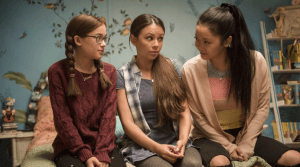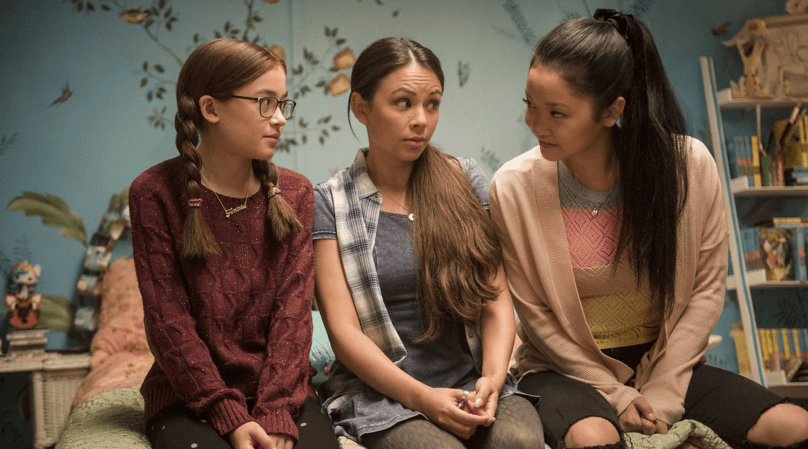by Claire Cheek, Ellen Nilsson, and Hannah Quiroz
 I’m sorry, isn’t this character,
I’m sorry, isn’t this character,
Long Duk Dong…
like, kinda racist?
Not “kind of.” Extremely racist.
So why do you like this movie?
Why are even asking that question?
Hello, Jake Ryan!
The movie date scene in Netflix’s new teen movie To All the Boys I’ve Loved Before has been revered in media as one of the of the most romantic segments of the film. Lara Jean Covey, the Korean-American protagonist, her fake boyfriend Peter Kavinsky, and her younger sister Kitty are all gathered around the TV watching the acclaimed romantic comedy 16 Candles. Their relationship is a fabrication; it exists only because Peter wants to make his ex-girlfriend jealous while Lara Jean wants to hide the fact she has a crush on her sister’s boyfriend.While watching this movie, Peter is quick to call out the racist nature of Long Duk Dong. An Asian exchange student, the character is portrayed as a filmic cliché that Asian men have been fighting against for some time. Lara Jean agrees yet plays it off because teen heartthrob Jake Ryan’s good looks in the film make the blatant racism acceptable. Lara Jean and her sister excuse the racial clowning of an Asian man because of their infatuation with a white man.
Netflix’s To All the Boys I’ve Loved Before has received constant praise for its representation of Asian-American actresses. But when taking a closer look, this film doesn’t exactly do the best job of representing people of color (PoC). The movie is based on a trilogy written by Jenny Han, a Korean-American author. When reaching out to production companies, she specified that she wanted Lara Jean and her sisters to be portrayed by Asian-American actresses. A firm advocate for representation in films and media, she stated in an interview that “there is power in seeing a face that looks like yours do something, be someone. There is power in moving from the sidelines to the center.” However, it was apparent that the race of the characters was unimportant to an array of companies. Han recalls:
One producer said to me, as long as the actress captures the spirit of the character, age and race don’t matter. I said, well, her spirit is Asian–American. That was the end of that.
Eventually, she found a group who agreed: Lana Condor, a young Vietnamese actress, was cast as Lara Jean. Despite Han’s fight for representation in the film, racial issues are still present. For example, there are only five people of color speaking roles in the film and one of them has less than five minutes of screen time. Lara Jean spends her time dreaming and chasing white men such as Jake Ryan in 16 Candles; Peter and Josh, her two love interests, are both white. Representation needs to be present on both sides as it is “especially significant when Asian men are cast in romantic roles to counteract the history of Western media portrayals that have desexualized and emasculated them.” White men are placed on a pedestal above Asian men in a movie where inclusion and representation are otherwise important. It may be that the movie represents a “fetishization of inclusion, not equality,” even though the post-release praise gives off the idea that the movie is flawless in its execution of equality.
Although race is not central to the plot of the movie it does not mean that representation does not matter. The novel itself does not explicitly state the race nor ethnicities of Lara Jean’s love interests, though they can be inferred through names and descriptions. Of the five boys, one character, Lucas Krapf, is renamed Lucas James and played by a black actor (Trezzo Mahoro). Just like the simple change that was made with Lucas’s character, similar small changes could have been made to incorporate more people of color actors into the film.
The director Susan Johnson reveals her so-called difficulties in finding Asian American actors, specifically Korean-American actresses. In response to a question about how the actresses do not represent Korean Americans, she says
That is something that I wanted to talk about a little bit, because it is virtually impossible. There are just not hundreds upon hundreds of specific Korean-American actors for roles.
Asian-American actors only constitute about 5% of all roles in Hollywood and less than 1% are in leading roles. Considering there are more than 11 million Asian Americans residing in the United States, the proportion of representation is drastically low. The director claims it was difficult to find Asian-American actresses. Since she did not care much for staying true to Korean Americans, why was it so necessary to make sure the actresses were American? After all, Anna Cathcart, who plays the youngest Covey sister, is Canadian. Surely there are more than three Asian Americans who work in the film industry (here’s a link to 29 Asian actors under 30). Overall there could have been greater representation of people of color in minor characters.
Johnson later goes on to describe the process of finding Lara Jean’s sisters. She claims th at
at
“Once we had Lana [Condor, who plays Lara Jean Song Covey] then it became about not trying to figure out if the girls looked alike, because that can vary in every family anyway. Especially when it is mixed race.”
Johnson, a white woman, whether she knows it or not, is perpetuating the idea of cultural homogeneity. When integral identities of characters are erased and then replaced with a “similar” identity, it ignores cultural differences. Her complete disregard for finding actresses that look alike show the biases between white and Asian casting. When white families are paired in films, casting is done to specifically find characters that look similar. For Johnson to go on to say that siblings’ phenotypes differ even more so in mixed families further exemplifies her lack of knowledge and disrespect of people of color.
One of the reasons the film is so popular is because the plot of the film could be applied to anyone. It allows for Asian-American characters to defy the typecasts they usually face and represent a normal everyday American family. But this is not enough. Representation matters, and the film industry needs to stop whitewashing characters. Instead, films’ creators should actively seek people of color, especially in leading roles. If directors continue to be ignorant about finding PoC talent, then how will anything about representation change? The answer is probably not more PoC actors. They already exist. What Hollywood needs, it seems, are more filmmakers and directors who are people of color.
Claire Cheek, Ellen Nilsson, and Hannah Quiroz are students in English 291: What Is Racial Difference?

